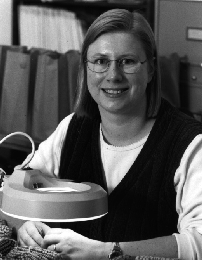Pumping Iron
All plants require iron for normal growth and development.
When sufficient quantities of iron are not available, symptoms of
iron-deficiency develop.
 Due to its poor solubility, iron is present in soil water in extremely low
concentrations. In response to the paucity of available iron in soil water,
several mechanisms for its uptake have evolved. One of these mechanisms,
chelation, is operative in the grasses, the group of flowering plants that
includes important agricultural crops such as corn, wheat, and rice.
Grass roots secrete compounds called phytosiderophores which chelate iron ions
present in soil water.
Dr. Elsbeth Walker and her research team
have cloned the yellow stripe 1 (ys 1) gene and shown that the
product of chelation, the phytosiderophore-iron complex, is moved across the
plasma membrane of corn root cells by the protein Yellow Stripe 1 (YS 1).
This study appeared in a recent issue of the journal Nature.
Due to its poor solubility, iron is present in soil water in extremely low
concentrations. In response to the paucity of available iron in soil water,
several mechanisms for its uptake have evolved. One of these mechanisms,
chelation, is operative in the grasses, the group of flowering plants that
includes important agricultural crops such as corn, wheat, and rice.
Grass roots secrete compounds called phytosiderophores which chelate iron ions
present in soil water.
Dr. Elsbeth Walker and her research team
have cloned the yellow stripe 1 (ys 1) gene and shown that the
product of chelation, the phytosiderophore-iron complex, is moved across the
plasma membrane of corn root cells by the protein Yellow Stripe 1 (YS 1).
This study appeared in a recent issue of the journal Nature.
The cloning of ys 1 is a significant advance in the elucidation of the
mechanism by which grasses acquire and distribute iron. An understanding
of iron uptake may permit the engineering of iron-rich crop plants that could
play an important role in alleviating iron deficiency anemia which afflicts
three billion people worldwide. Since the iron phytosiderophore chelates
ions other than iron, plants into which ys 1 has been inserted might
prove useful for the removal of metal ions from contaminated soils.